Analysis of the Location Factors Affecting the Price of Tourist Houses: The Role of Accessibility to Public Transport Stations in Madrid
Abstract
:1. Introduction
2. Materials and Methods
2.1. Madrid as a Case Study
2.2. Statistical Methods
2.2.1. Literature Review
- (1)
- (2)
- (3)
- Aspects referring to the location, such as the proximity to the city centre and other tourist attractions. Usually, the proximity to these places increases the prices of the hotels [57], although it is also possible that there are cheaper hotels in central locations due to greater spatial competition compared with suppliers in the outskirts [46].
2.2.2. Statistical Methods
2.2.3. Variables Analysed—Source: Own Elaboration
3. Results and Discussion
4. Conclusions
Author Contributions
Funding
Institutional Review Board Statement
Informed Consent Statement
Data Availability Statement
Conflicts of Interest
References
- European Commission. Communication from the Commission to the European Parliament, the Council, The European Economic and Social Committee and The Committee of the Regions; A European Agenda for the Collaborative Economy; 2.6.2016 COM(2016) 356 Final; European Commission: Brussels, Belgium, 2016. [Google Scholar]
- Dogru, T.; Mody, M.; Suess, C.; Line, N.; Bonn, M. Airbnb 2.0: Is it a sharing economy platform or a lodging corporation? Tour. Manag. 2020, 78, 104049. [Google Scholar] [CrossRef]
- Guttentag, D.; Smith, S.; Potwarka, L.; Havitz, M. Why tourists choose Airbnb: A motivation-based segmentation study. J. Travel Res. 2018, 57, 342–359. [Google Scholar] [CrossRef]
- Zervas, G.; Proserpio, D.; Byers, J.W. The Rise of the Sharing Economy: Estimating the Impact of Airbnb on the Hotel Industry. J. Mark. Res. 2017, 54, 687–705. [Google Scholar] [CrossRef]
- Bendickson, J.S.; Muldoon, J.; Liguori, E.W.; Midgett, C. High performance work systems: A necessity for startups. J. Small Bus. Strategy 2017, 27, 1–12. [Google Scholar]
- Lockyer, T. The perceived importance of price as one hotel selection dimension. Tour. Manag. 2005, 26, 529–537. [Google Scholar] [CrossRef]
- Chattopadhyay, M.; Mitra, S.K. Do airbnb host listing attributes influence room pricing homogenously? Int. J. Hosp. Manag. 2019, 81, 54–64. [Google Scholar] [CrossRef]
- Rosen, S. Hedonic prices and implicit markets: Product differentiation in pure competition. J. Political Econ. 1974, 82, 34–55. [Google Scholar] [CrossRef]
- Contu, G.; Frigau, L.; Conversano, C. Price indicators for Airbnb accommodations. Qual. Quant. 2023, 57, 4779–4802. [Google Scholar] [CrossRef]
- Önder, I.; Weismayer, C.; Gunter, U. Spatial price dependencies between the traditional accommodation sector and the sharing economy. Tour. Econ. 2019, 25, 1150–1166. [Google Scholar] [CrossRef]
- Türk, U.; Östh, J.; Kourtit, K.; Nijkamp, P. The path of least resistance explaining tourist mobility patterns in destination areas using Airbnb data. J. Transp. Geogr. 2021, 94, 103130. [Google Scholar] [CrossRef]
- Deboosere, R.; Kerrigan, D.J.; Wachsmuth, D.; El-Geneidy, A. Location, location and professionalization: A multilevel hedonic analysis of Airbnb listing prices and revenue. Reg. Stud. Reg. Sci. 2019, 6, 143–156. [Google Scholar] [CrossRef]
- Voltes-Dorta, A.; Sánchez-Medina, A. Drivers of Airbnb prices according to property/room type, season and location: A regression approach. J. Hosp. Tour. Manag. 2020, 45, 266–275. [Google Scholar] [CrossRef]
- Ayuntamiento de Madrid. Metodología para la Elaboración del Índice de Vulnerabilidad Territorial de Barrios y Distritos de Madrid y Ranking de Vulnerabilidad; Coordinación Territorial y Cooperación Político-Social de Madrid: Madrid, Spain, 2018. [Google Scholar]
- Tammaru, T.; van Ham, M.; Marcińczak, S.; Musterd, S. (Eds.) Socio-Economic Segregation in European Capital Cities: East Meets West; Routledge: London, UK, 2016. [Google Scholar]
- Rodríguez Suárez, I.; Álvarez del Valle, L.; Fernández Ramírez, C.; Hernández Aja, A. El imposible acceso a la vivienda en Madrid: Cuando los precios superan a las rentas. Ciudad. Y Territ. Estud. Territ. (CyTET) 2023, 55, 61–76. [Google Scholar] [CrossRef]
- Leal-Maldonado, J.; Martínez-del Olmo, A. El ocaso de un modelo de vivienda de difícil reemplazo. Ciudad. Y Territ. Estud. Territ. 2021, 53, 43–60. [Google Scholar] [CrossRef]
- Domínguez-Pérez, M.; Leal-Maldonado, J.; Barañano-Cid, M. Vivienda, transformaciones urbanas y desigualdad socioespacial en las grandes ciudades españolas. Ciudad. Y Territ. Estud. Territ. 2021, 53, 5–12. [Google Scholar] [CrossRef]
- Rodríguez-Suárez, I.; Hernández-Aja, A.; GómezGiménez, J.; Matesanz-Parellada, Á.; DíezBermejo, A. Los Catálogos de Barrios Vulnerables de España. Análisis de la vulnerabilidad en las ciudades españolas entre 1991 y 2011. Ciudad y Territorio. Estud. Territ. (CyTET) 2021, 53, 179–200. [Google Scholar] [CrossRef]
- Gil, J.; Sequera, J. Expansión de la ciudad turística y nuevas resistencias. El caso de Airbnb en Madrid. Empiria 2018, 41, 15–31. [Google Scholar] [CrossRef]
- Crespi-Vallbona, M.; Domínguez-Pérez, M. Las consecuencias de la turistificación en el centro de las grandes ciudades: El caso de Madrid y Barcelona. Ciudad. Y Territ. Estud. Territ. 2021, 53, 61–82. [Google Scholar] [CrossRef]
- Ioannides, D.; Röslmaier, M.; van der Zee, E. Airbnb as an instigator of ‘tourism bubble’ expansion in Utrecht’s Lombok neighbourhood. Tour. Geogr. 2018, 21, 1–19. [Google Scholar] [CrossRef]
- Wegmann, J.; Jiao, J. Taming Airbnb: Toward guiding principles for local regulation of urban vacation rentals based on empirical results from five US cities. Land Use Policy 2017, 69, 494–501. [Google Scholar] [CrossRef]
- Ardura Urquiaga, Á.; Lorente Riverola, I.; Mohíno Sanz, M.I.; Ruiz Sánchez, J. “No estamos tan mal como Barcelona”: Análisis de la proliferación y regulación de las viviendas de uso turístico en Madrid y Barcelona = “We are not as crowded as Barcelona”: The proliferation and regulation of vacational rentals in Madrid and Barcelona. BAGE Boletín Asoc. Geógrafos Españoles 2019, 83, 1–47. [Google Scholar]
- Ayuntamiento de Madrid. Portal de Transparencia. Estudio de la Movilidad de la Ciudad de Madrid. 2019. Available online: https://transparencia.madrid.es/portales/transparencia/es/Transparencia-porsectores/Movilidad/Trafico/Estudios-Informes-y-Evaluaciones-de-Movilidad (accessed on 1 January 2020).
- Flor, M.; Ortuño, A.; Guirao, B. Ride-hailing services: Competition or complement to public transport to reduce accident rates. The case of Madrid. Front. Psychol. 2022, 13, 951258. [Google Scholar] [CrossRef] [PubMed]
- Ayuntamiento de Denia-Alicante University. Diagnóstico Relativo a Las Viviendas de Uso Turístico Ofertadas por Plataformas on-Line en Denia. 2023. Available online: https://www.denia.es/adjuntos/directori/docs/452.pdf (accessed on 30 May 2024).
- Gibbs, C.; Guttentag, D.; Gretzel, U.; Morton, J.; Goodwill, A. Pricing in the sharing economy: A hedonic pricing model applied to Airbnb listings. J. Travel Tour. Mark. 2018, 35, 46–56. [Google Scholar] [CrossRef]
- Yoo, M.; Lee, S.; Bai, B. Hospitality marketing research from 2000 to 2009: Topics, methods, and trends. Int. J. Contemp. Hosp. Manag. 2011, 23, 517–532. [Google Scholar] [CrossRef]
- Lancaster, K.J. A new approach to consumer theory. J. Political Econ. 1966, 74, 132–157. [Google Scholar] [CrossRef]
- Mitsis, P. Hedonic Price Analysis of Hotel Rooms in Cyprus. J. Hosp. Financ. Manag. 2022, 30, 17. [Google Scholar]
- Glaesener, M.-L.; Caruso, G. Neighborhood green and services diversity effects on land prices: Evidence from a multilevel hedonic analysis in Luxembourg. Landsc. Urban Plan. 2015, 143, 100–111. [Google Scholar] [CrossRef]
- Li, M.M.; Brown, H.J. Micro-neighborhood externalities and hedonic housing prices. Land Econ. 1980, 56, 125–141. [Google Scholar] [CrossRef]
- Armstrong, R.J.; Rodriguez, D.A. An evaluation of the accessibility benefits of commuter rail in eastern Massachusetts using spatial hedonic price functions. Transportation 2006, 33, 21–43. [Google Scholar] [CrossRef]
- Benjamin, J.D.; Sirmans, G.S. Mass transportation, apartment rent and property values. J. Real Estate Res. 1996, 12, 1–8. [Google Scholar] [CrossRef]
- Chatman, D.G.; Tulach, N.K.; Kim, K. Evaluating the economic impacts of light rail by measuring home appreciation: A first look at New Jersey’s River line. Urban Stud. 2012, 49, 467–487. [Google Scholar] [CrossRef]
- Lewis-Workman, S.; Brod, D. Measuring the neighborhood benefits of rail transit accessibility. Transp. Res. Rec. J. Transp. Res. Board 1997, 1576, 147–153. [Google Scholar] [CrossRef]
- Franklin, J.P.; Waddell, P. A hedonic regression of home prices in King County, Washington, using activityspecific accessibility measures. In Proceedings of the Transportation Research Board 82nd Annual Meeting, Washington, DC, USA, 12–16 January 2003. [Google Scholar]
- Rauterkus, S.Y.; Miller, N. Residential land values and walkability. J. Sustain. Real Estate 2011, 3, 23–43. [Google Scholar] [CrossRef]
- El-Geneidy, A.; Lierop, D.V.; Wasfi, R. Do people value bicycle sharing? A multilevel longitudinal analysis capturing the impact of bicycle sharing on residential sales in Montreal, Canada. Transp. Policy 2016, 51, 174–181. [Google Scholar] [CrossRef]
- Papatheodorou, A.; Lei, Z.; Apostolakis, A. Hedonic price analysis. In Handbook of Research Methods in Tourism; Edward Elgar Publishing: Cheltenham, UK, 2012. [Google Scholar]
- Portolan, A. Impact of the attributes of private tourist accommodation facilities onto prices: A hedonic price approach. Eur. J. Tour. Res. 2013, 6, 74–82. [Google Scholar] [CrossRef]
- Pawlicz, A.; Napierala, T. The determinants of hotel room rates: Analysis of the hotel industry in Warsaw, Poland. Int. J. Contemp. Hosp. Manag. 2016, 29, 571–588. [Google Scholar] [CrossRef]
- Wang, X.; Suna, J.; Wen, H. Tourism seasonality, online user rating and hotel price: A quantitative approach based on the hedonic price model. Int. J. Hosp. Manag. 2019, 79, 140–147. [Google Scholar] [CrossRef]
- Bull, A.O. Pricing a motel’s location. Int. J. Contemp. Hosp. Manag. 1994, 6, 10–15. [Google Scholar] [CrossRef]
- Chen, C.-F.; Rothschild, R. An application of hedonic pricing analysis to the case of hotel rooms in Taipei. Tour. Econ. 2010, 16, 685–694. [Google Scholar] [CrossRef]
- Herrin, W.E.; Carvell, S.A. Pricing in the hospitality industry: An implicit markets approach. Hosp. Rev. 1990, 8, 27. [Google Scholar]
- Lee, D.; Hyun, W.; Ryu, J.; Lee, W.J.; Rhee, W.; Suh, B. An analysis of social features associated with room sales of Airbnb. In Proceedings of the ACM Conference Companion on Computer Supported Cooperative Work & Social Computing, Vancouver, BC, Canada, 14–18 March 2015. [Google Scholar]
- Zhang, Z.; Ye, Q.; Law, R. Determinants of hotel room price: An exploration of travelers’ hierarchy of accommodation needs. Int. J. Contemp. Hosp. Manag. 2011, 23, 972–981. [Google Scholar] [CrossRef]
- Hill, D. How much is your spare room worth? IEEE Spectrum 2015, 52, 32–58. [Google Scholar] [CrossRef]
- Teubner, T.; Hawlitschek, F.; Dann, D. Price determinants on Airbnb: How reputation pays off in the sharing economy. J. Self-Gov. Manag. Econ. 2017, 5, 53–80. [Google Scholar]
- Wang, D.; Nicolau, J.L. Price determinants of sharing economy based accommodation rental: A study of listings from 33 cities on Airbnb.com. Int. J. Hosp. Manag. 2017, 62, 120–131. [Google Scholar] [CrossRef]
- Schamel, G. Weekend vs. midweek stays: Modelling hotel room rates in a small market. Int. J. Hosp. Manag. 2012, 31, 1113–1118. [Google Scholar] [CrossRef]
- Becerra, M.; Santaló, J.; Silva, R. Being better vs. being different: Differentiation, competition, and pricing strategies in the Spanish hotel industry. Tour. Manag. 2013, 34, 71–79. [Google Scholar] [CrossRef]
- Masiero, L.; Nicolau, J.L.; Law, R. A demand-driven analysis of tourist accommodation price: A quantile regression of room bookings. Int. J. Hosp. Manag. 2015, 50, 1–8. [Google Scholar] [CrossRef]
- Yang, Y.; Mueller, N.J.; Croes, R.R. Market accessibility and hotel prices in the Caribbean: The moderating effect of quality-signaling factors. Tour. Manag. 2016, 56, 40–51. [Google Scholar] [CrossRef]
- Soler, I.P.; Gemar, G. Hedonic price models with geographically weighted regression: An application to hospitality. J. Destin. Mark. Manag. 2018, 9, 126–137. Available online: https://scholarworks.umass.edu/jhfm/vol30/iss1/17 (accessed on 1 January 2020). [CrossRef]
- Chen, Y.; Xie, K.L. Consumer valuation of airbnb listings: A hedonic pricing approach. Int. J. Contemp. Hosp. Manag. 2017, 29, 2405–2424. [Google Scholar] [CrossRef]
- Gunter, U.; Önder, I. Determinants of Airbnb demand in Vienna and their implications for the traditional accommodation industry. Tour. Econ. 2018, 24, 270–293. [Google Scholar] [CrossRef]
- Lorde, T.; Jacob, J.; Weekes, Q. Price-setting behavior in a tourism sharing economy accommodation market: A hedonic price analysis of AirBnB hosts in the caribbean. Tour. Manag. Perspect. 2019, 30, 251–261. [Google Scholar] [CrossRef]
- Magno, F.; Cassia, F.; Ugolini, M.M. Accommodation prices on airbnb: Effects of host experience and market demand. TQM J. 2018, 30, 608–620. [Google Scholar] [CrossRef]
- Perez-Sanchez, V.R.; Serrano-Estrada, L.; Marti, P.; Mora-Garcia, R.-T. The what, where, and why of airbnb price determinants. Sustainability 2018, 10, 4596. [Google Scholar] [CrossRef]
- Chau, K.W.; Chin, T.L. A critical review of literature on the hedonic price model. Int. J. Hous. Sci. Its Appl. 2003, 27, 145–165. [Google Scholar]
- Loo, B.P.Y. Transport geography: Towards a more people-oriented approach in the last 25 years. J. Transpor Geogr. 2019, 81. [Google Scholar] [CrossRef]
- Kozak, M. Comparative analysis of tourist motivations by nationality and destinations. Tour. Manag. 2002, 23, 221–232. [Google Scholar] [CrossRef]
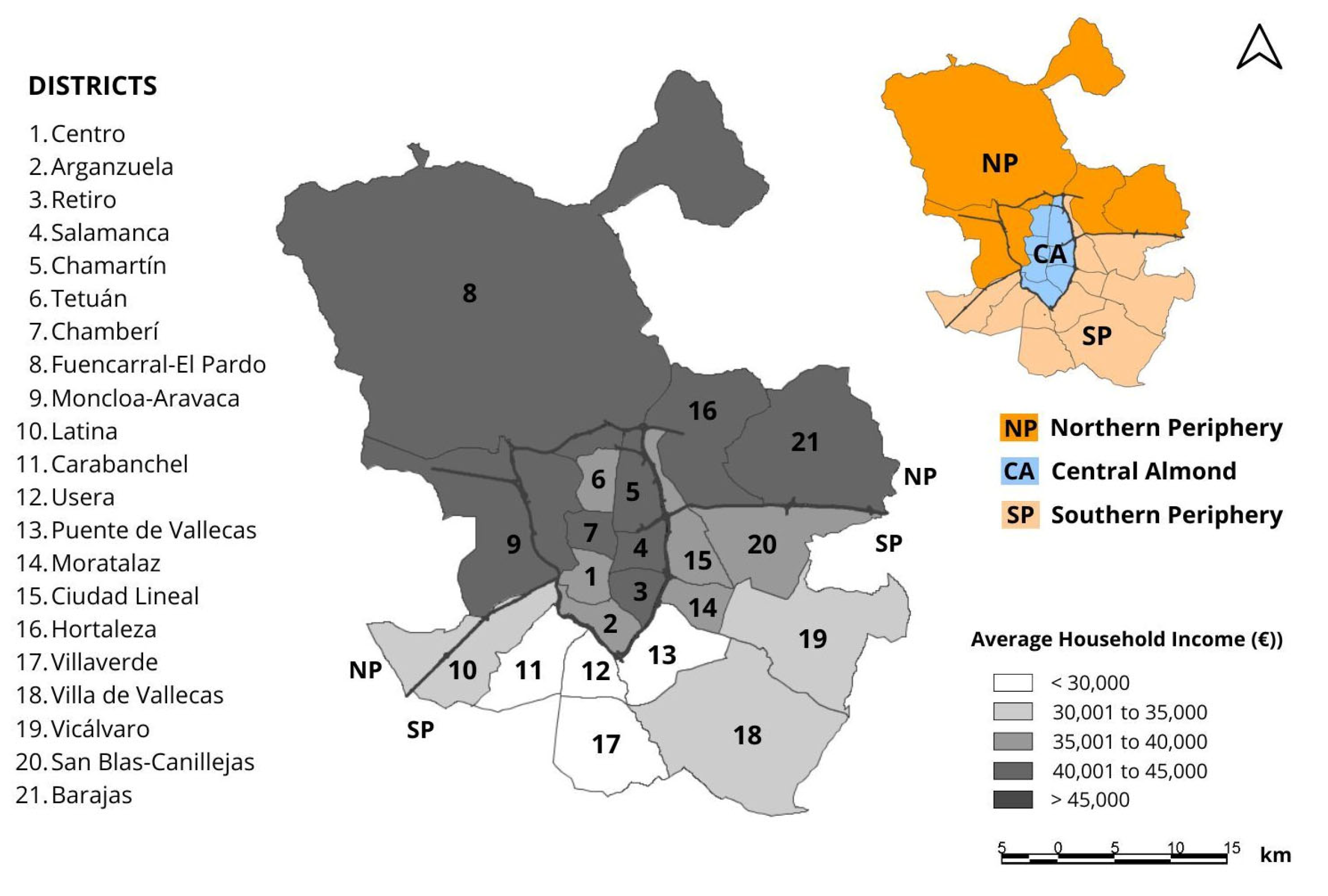
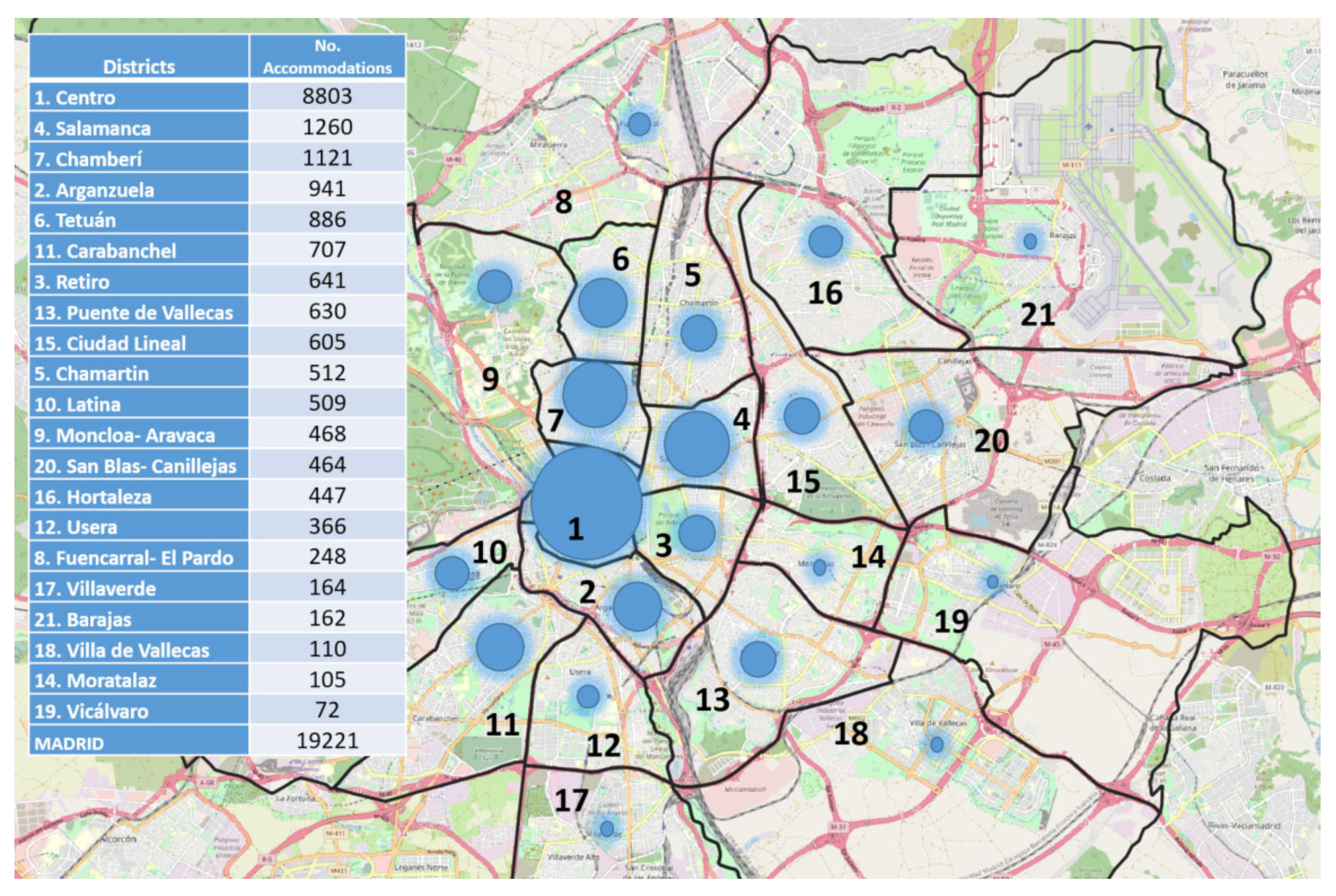
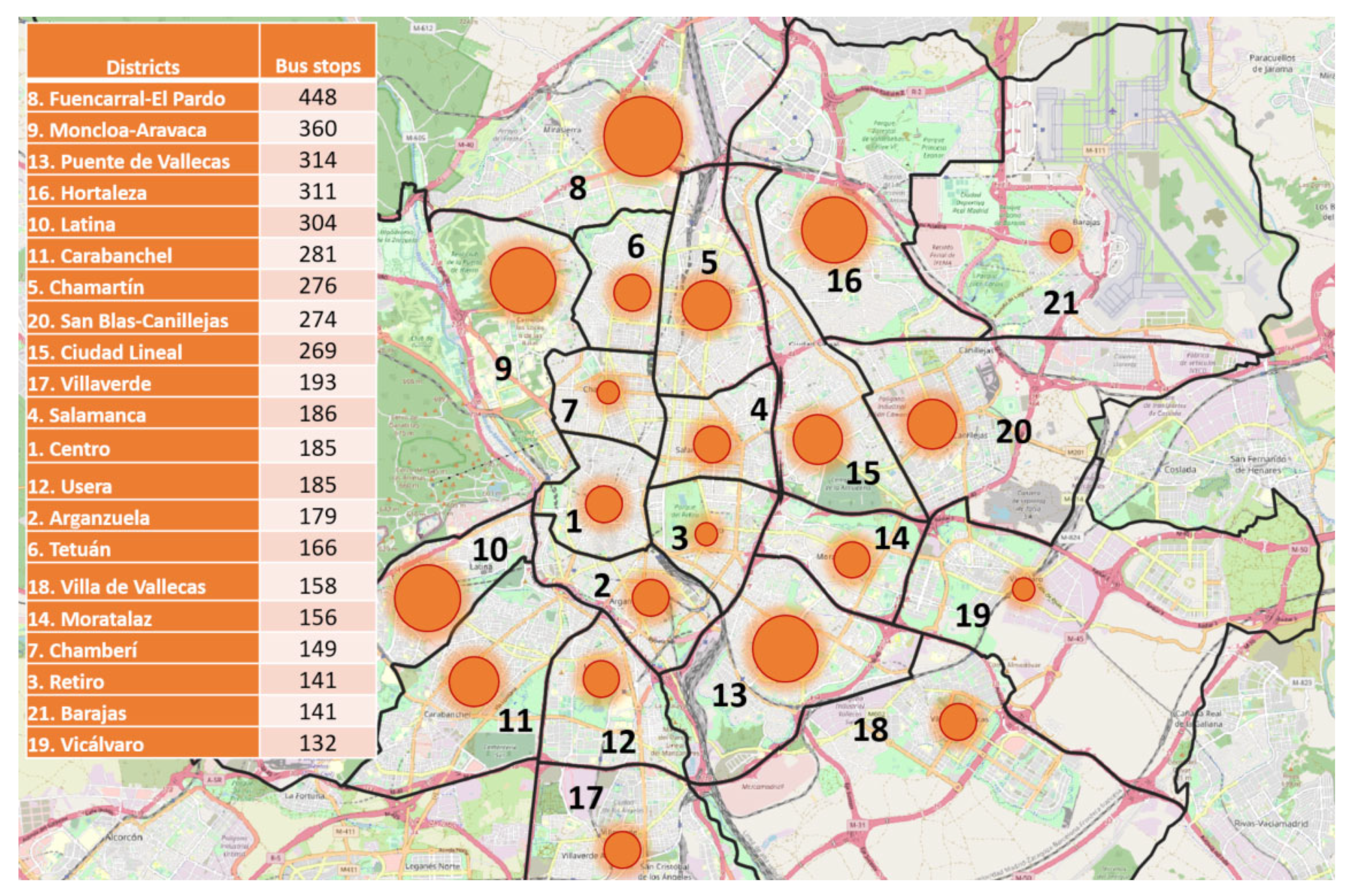
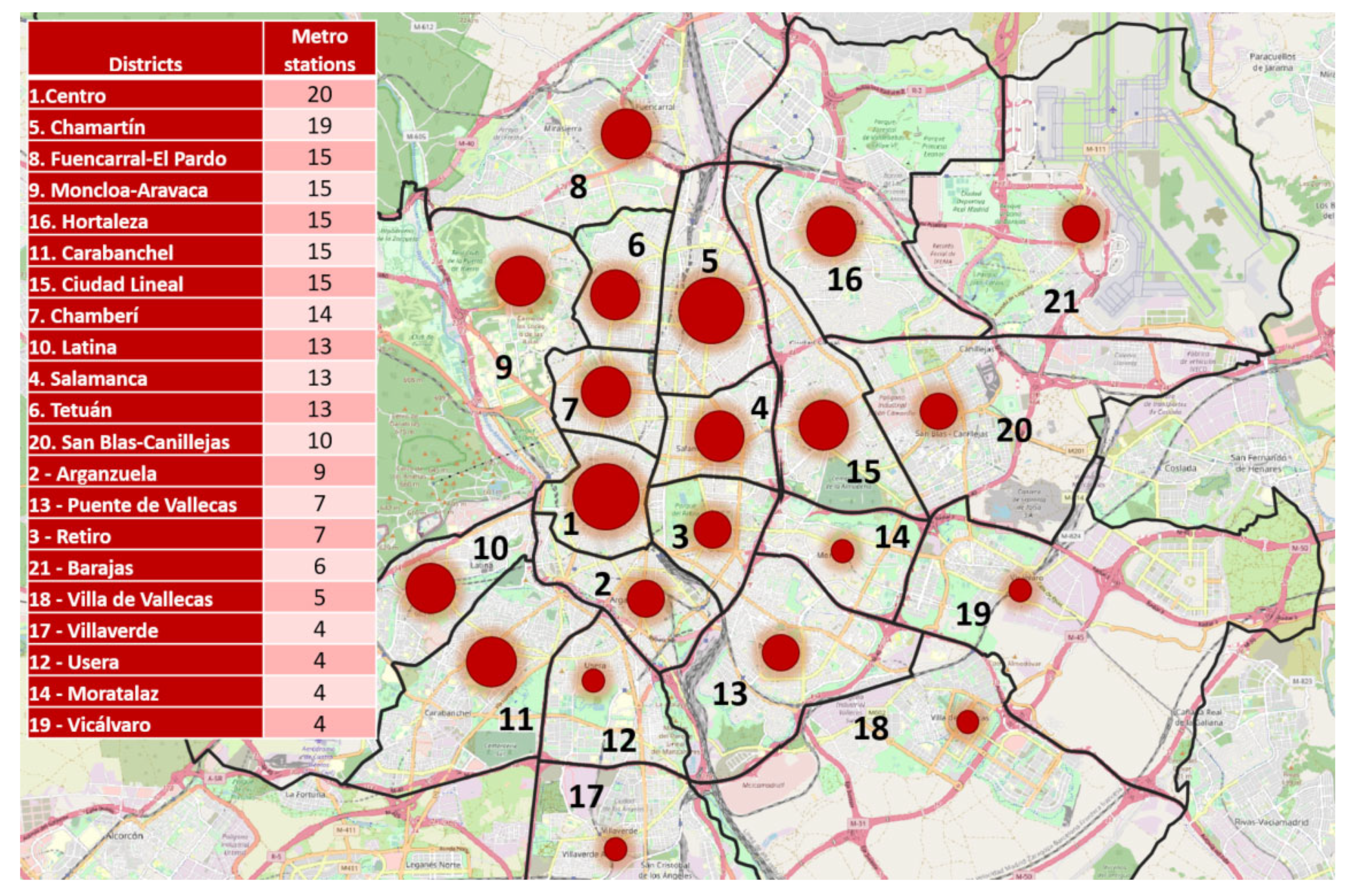

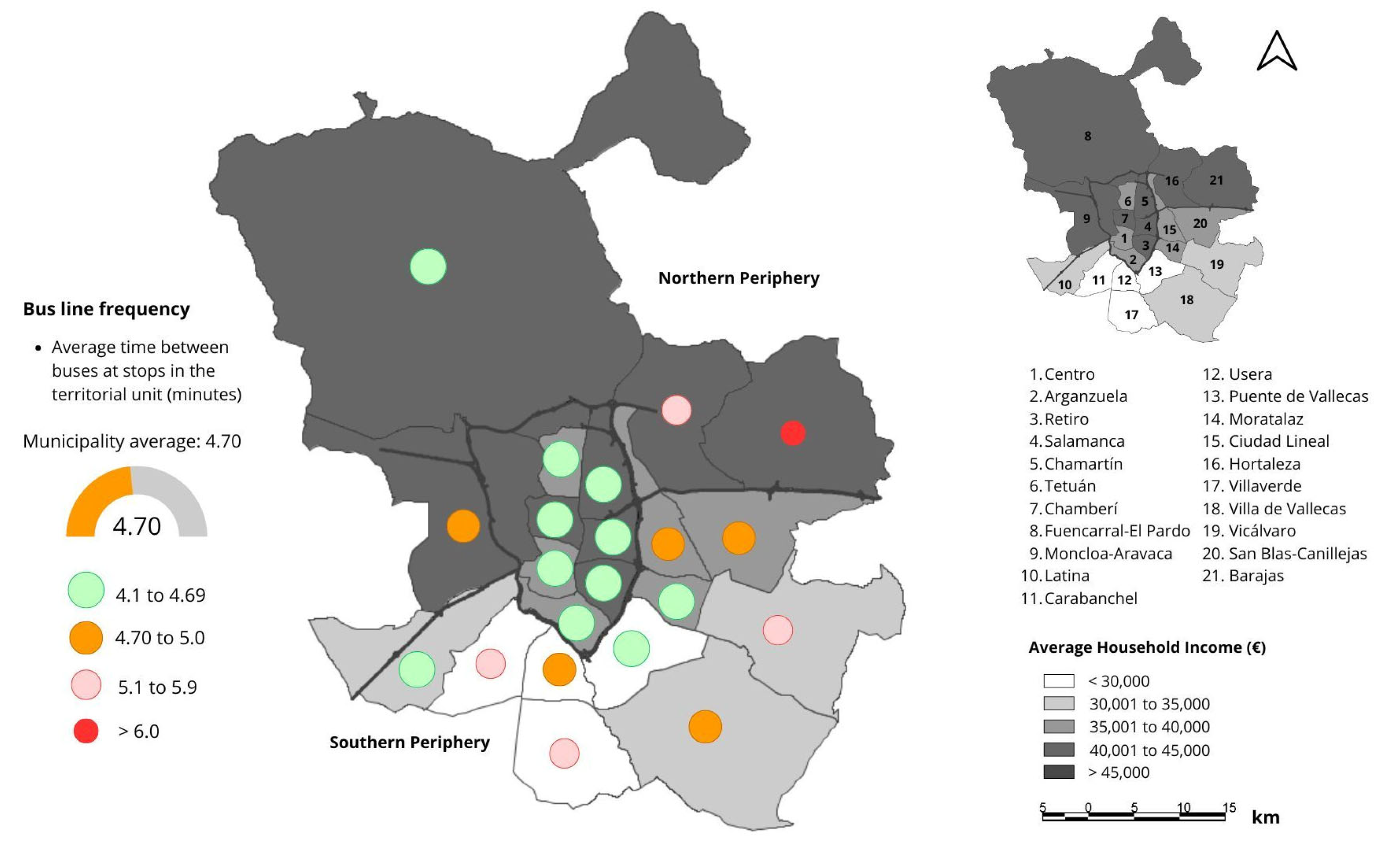
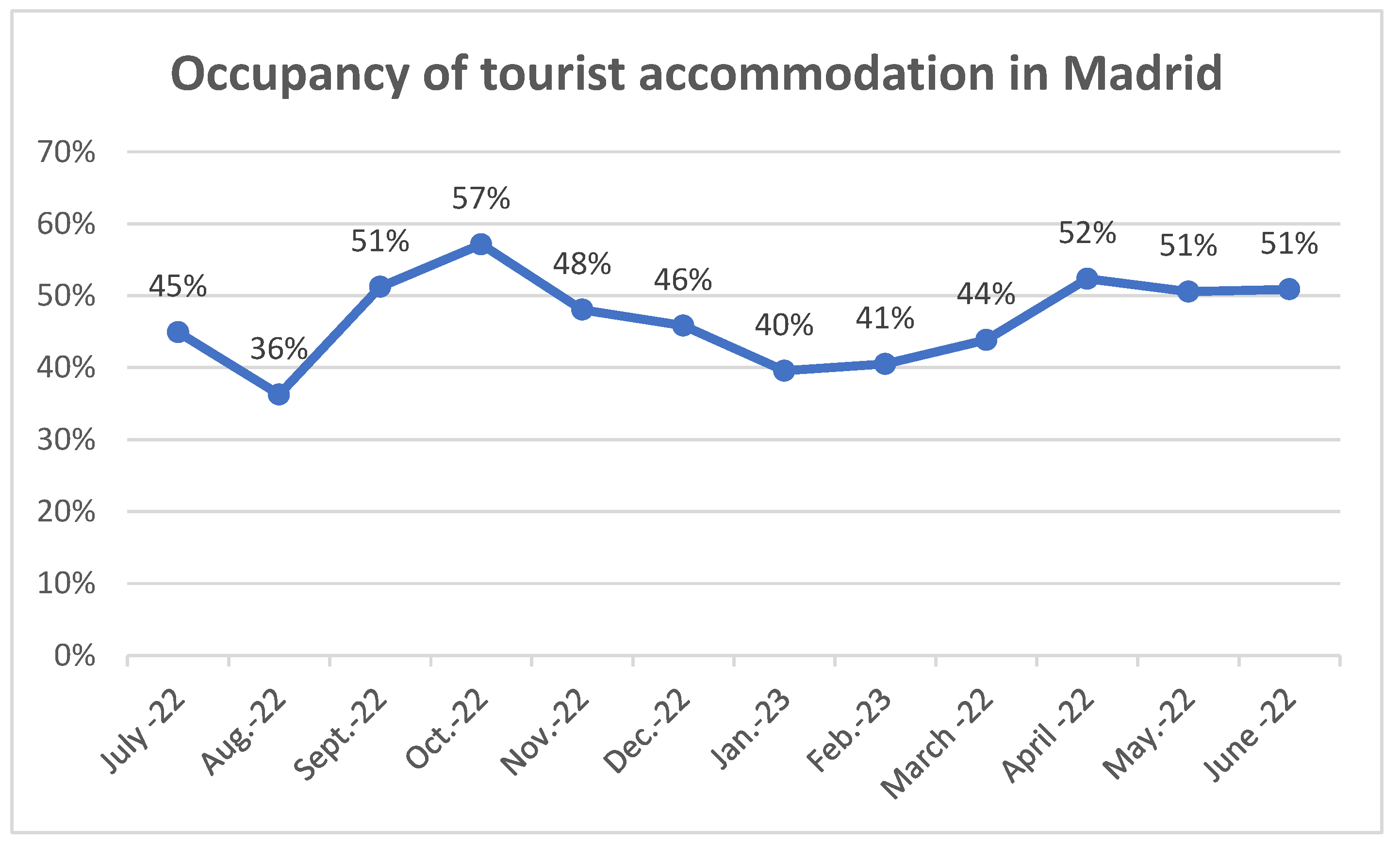
| Variables | Definition | Source |
|---|---|---|
| Dependent | ||
| Price | Rate per night (USD) | AirDNA Platform |
| Independent | ||
| General characteristics | AirDNA Platform | |
| Rooms | Number of rooms in the property | |
| Bathrooms | Number of bathrooms in the property | |
| Minimum stay | Minimum stay, measured as nights, established by the owner | |
| Guests | Maximum number of guests allowed | |
| Occupation | Number of nights reserved (number of nights reserved + number of nights available). | |
| Location and neighbourhood variables | ||
| Centre | Dummy variable if the property is located in the Centro district | Own elaboration based on geospatial analysis with ArcGIS |
| Periphery | Dummy variable if the property is located outside of the “Central Almond” | |
| Bus | Distance of the property from the nearest bus stop (km) | |
| Metro | Distance of the property from the nearest metro station (km) | |
| Train | Distance of the property from the nearest train station (km) | |
| Puerta del Sol | Distance of the property from the Puerta del Sol (km) | |
| Income | Average household income in the district where the property is located (In) | Spanish Statistical Office (INE), 2018. |
| Variable | February 2023 | October 2022 | ||
|---|---|---|---|---|
| Mean | Std. Dev | Mean | Std. Dev | |
| Price | 4.9266 | 0.4952 | 4.9693 | 0.5687 |
| Rooms | 1.5162 | 0.9882 | 1.5223 | 1.0250 |
| Bathrooms | 1.3265 | 0.6129 | 1.3127 | 0.6129 |
| Stay | 4.8120 | 18.0506 | 4.7977 | 17.9501 |
| Guests | 4.0527 | 1.9762 | 4.0730 | 2.1440 |
| Occupation | 0.5783 | 0.3374 | 0.7583 | 0.3176 |
| Centre | 0.5490 | 0.4976 | 0.5560 | 0.4969 |
| Periphery | 0.1724 | 0.3778 | 0.1666 | 0.3727 |
| Bus | 0.1025 | 0.6951 | 0.1017 | 0.6949 |
| Metro | 0.2459 | 0.3180 | 0.2317 | 0.2083 |
| Train | 0.9382 | 0.7464 | 0.9313 | 0.7326 |
| Puerta del Sol | 2.1027 | 2.1857 | 2.0731 | 2.1571 |
| Income | 10.6130 | 0.2250 | 10.6051 | 0.2309 |
| Obs | 7895 | 9174 | ||
| Variable | February 2023 | October 2022 | ||
|---|---|---|---|---|
| VIF | 1/VIF | VIF | 1/VIF | |
| Rooms | 2.98 | 0.335212 | 2.87 | 0.348301 |
| Bathrooms | 1.93 | 0.518879 | 1.88 | 0.532084 |
| Stay | 1.01 | 0.989825 | 1.01 | 0.987231 |
| Guests | 2.67 | 0.374084 | 2.52 | 0.397182 |
| Occupation | 1.03 | 0.973520 | 1.02 | 0.976820 |
| Centre | 3.46 | 0.288700 | 3.30 | 0.302912 |
| Periphery | 2.44 | 0.410201 | 2.73 | 0.366181 |
| Bus | 1.06 | 0.946476 | 1.09 | 0.920264 |
| Metro | 1.36 | 0.732838 | 1.51 | 0.660152 |
| Train | 1.81 | 0.553370 | 1.78 | 0.561372 |
| Puerta del Sol | 3.65 | 0.273924 | 3.74 | 0.267452 |
| Income | 2.24 | 0.445690 | 2.25 | 0.443591 |
| Average VIF | 2.14 | 2.14 | ||
| Model 1 October 2022 | Model 2 February 2023 | |
|---|---|---|
| Characteristics of the property | ||
| Bathrooms | 0.227 *** (14.67) | 0.198 *** (13.24) |
| Guests | 0.0741 *** (17.20) | 0.0592 *** (17.08) |
| Stay | −0.00252 *** (−4.08) | −0.00122 * (−2.39) |
| Rooms | 0.0874 *** (8.85) | 0.124 *** (15.92) |
| Occupation | −0.420 *** (−17.16) | −0.144 *** (−25.77) |
| Location and neighbourhood variables | ||
| Centre | 0.103 *** (6.18) | 0.144 *** (9.79) |
| Periphery | −0.0188 (−0.95) | −0.00764 (−0.44) |
| Bus | −0.0639 (−1.09) | −0.114 * (−2.27) |
| Metro | −0.0608 * (−2.42) | −0.0114 (−0.80) |
| Train | −0.0149 + (−1.87) | −0.0295 *** (−4.26) |
| Puerta del Sol | −0.0425 *** (−10.81) | −0.0271 *** (−7.91) |
| Income | 0.356 *** (11.82) | 0.395 *** (14.50) |
| Constant | 0.884 *** (2.71) | 0.349 (1.19) |
| F | 455.64 | 534.56 |
| Prob > F | 0.0000 | 0.0000 |
| R-squared | 0.4467 | 0.5363 |
| Observations | 9174 | 7895 |
Disclaimer/Publisher’s Note: The statements, opinions and data contained in all publications are solely those of the individual author(s) and contributor(s) and not of MDPI and/or the editor(s). MDPI and/or the editor(s) disclaim responsibility for any injury to people or property resulting from any ideas, methods, instructions or products referred to in the content. |
© 2024 by the authors. Licensee MDPI, Basel, Switzerland. This article is an open access article distributed under the terms and conditions of the Creative Commons Attribution (CC BY) license (https://creativecommons.org/licenses/by/4.0/).
Share and Cite
Valenzuela, P.; Ortuño, A.; Flor, M.; Guirao, B. Analysis of the Location Factors Affecting the Price of Tourist Houses: The Role of Accessibility to Public Transport Stations in Madrid. Sustainability 2024, 16, 4768. https://doi.org/10.3390/su16114768
Valenzuela P, Ortuño A, Flor M, Guirao B. Analysis of the Location Factors Affecting the Price of Tourist Houses: The Role of Accessibility to Public Transport Stations in Madrid. Sustainability. 2024; 16(11):4768. https://doi.org/10.3390/su16114768
Chicago/Turabian StyleValenzuela, Patricia, Armando Ortuño, María Flor, and Begoña Guirao. 2024. "Analysis of the Location Factors Affecting the Price of Tourist Houses: The Role of Accessibility to Public Transport Stations in Madrid" Sustainability 16, no. 11: 4768. https://doi.org/10.3390/su16114768





